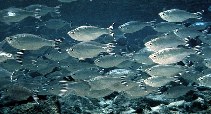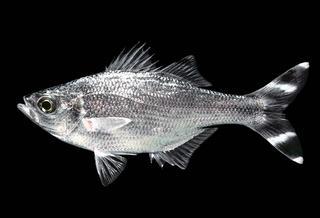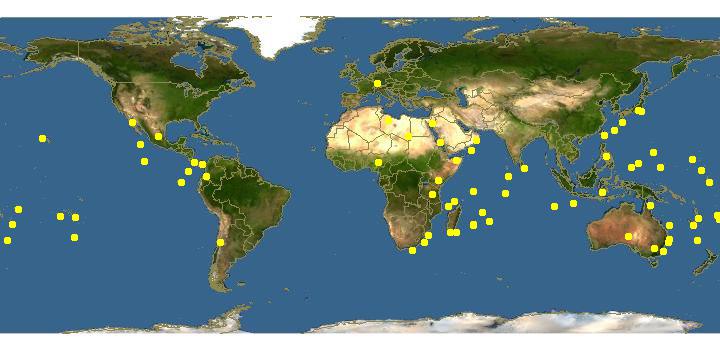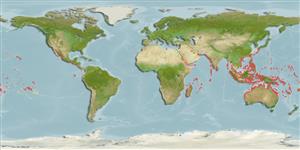|
| Links |
We parsed the following live from the Web into this page. Such content is managed by its original site and not cached on Discover Life. Please send feedback and corrections directly to the source. See original regarding copyrights and terms of use.
- Australian Faunal Directory
- FishBase
|
|
espa˝ol |
|
|
Overview | |
Main identification features
Head pointed; eye large; 1 dorsal fin, X, 9-11; anal rays III,9-11; pectoral rays 14; lateral-line scales 48-56; mouth short, oblique; lower jaw projecting; preorbital and preopercular margins serrate; operculum with 2 flat spines; a single dorsal fin with notch between spinous and soft portions; dorsal and anal fins with well developed scaly sheath.
Overall silvery; tail fin white, with five black bands.
Size: reaches 50 cm.
Habitat: usually seen in large aggregations in rocky areas affected by surge; the young inhabit tide pools; enters freshwater mouths of creeks.
Depth: 0-26 m.
Wide ranging in the tropical Indo-Pacific from East Africa to the eastern Pacific; ranges from the tip of Baja California to Ecuador and the oceanic islands.
Attributes
Abundance: Common.
Cites: Not listed.
Climate Zone: North Temperate (Californian Province &/or Northern Gulf of California); Northern Subtropical (Cortez Province + Sinaloan Gap); Northern Tropical (Mexican Province to Nicaragua + Revillagigedos); Equatorial (Costa Rica to Ecuador + Galapagos, Clipperton, Cocos, Malpelo).
Depth Range Max: 26 m.
Depth Range Min: 0 m.
Diet: zooplankton; bony fishes; Pelagic crustacea.
Eastern Pacific Range: Northern limit=24; Southern limit=-2; Western limit=-115; Eastern limit=-78; Latitudinal range=26; Longitudinal range=37.
Egg Type: Pelagic; Pelagic larva.
Feeding Group: Planktivore.
FishBase Habitat: Reef Associated.
Global Endemism: Indo-Pacific only (Indian + Pacific Oceans); TEP non-endemic; West + East Pacific (but not Central); "Transpacific" (East + Central &/or West Pacific); All species.
Habitat: Reef associated (reef + edges-water column & soft bottom); Water column; Estuary; Freshwater.
Inshore Offshore: Inshore; Inshore Only.
IUCN Red List: Not evaluated / Listed.
Length Max: 50 cm.
Regional Endemism: Island (s); Continent; Continent + Island (s); Eastern Pacific non-endemic; Tropical Eastern Pacific (TEP) non-endemic; All species.
Residency: Resident.
Salinity: Brackish; Freshwater; Marine.
Water Column Position: Surface; Water column only;
|
|
|
Names | |
|
|
|
Links to other sites | |
|
|
|
References |
- Allen , G.R. and Robertson, D.R., 1994., Fishes of the Tropical Eastern Pacific., Crawford House Press Pty Ltd:1-332.
- Allen , G.R. and Robertson, D.R., 1997., An Annotated Checklist of the fishes of Clipperton Atoll, Tropical Eastern Pacific., Revista de Biologia Tropical, 45:813-843.
- Bloch , M. E. and Schneider, J. G., 1801., M. E. Blochii, Systema Ichthyologiae iconibus cx illustratum. Post obitum auctoris opus inchoatum absolvit, correxit, interpolavit Jo. Gottlob Schneider, Saxo. Berolini. Sumtibus Austoris Impressum et Bibliopolio Sanderiano Commissum., Systema Ichthyol., :1-584.
- Castro-Aguirre , J. L. , Balart , E. F. and Arvizu-MartÝnez, J., 1995., Contribuciˇn al conocimiento del origen y distribuciˇn de la ictiofauna del Golfo de California, MÚxico., Hidrobiologica, 5:57-78.
- Castro-Aguirre, J.L. and Balart, E.F., 2002., La ictiofauna de las islas Revillagigedos y sus relaciones zoogeograficas, con comentarios acerca de su origen y evolucion. En: Lozano-Vilano, M. L. (Ed.). Libro Jubilar en Honor al Dr. Salvador Contreras Balderas., Universidad Autonoma de Nuevo Leˇn:153-170.
- Findley, L.T., Hendrickx, M.E., Brusca, R.C., van der Heiden, A.M., Hastings, P.A., Torre, J., 2003., Diversidad de la Macrofauna Marina del Golfo de California, Mexico., CD-ROM versiˇn 1.0. Projecto de la Macrofauna del Golfo .á Derechos reservados de los autores y Conservaciˇn Internacional.
- Fischer , W. , Krup , F. , Schneider , W. , Sommer , C. , Carpenter , K. E. and Niem, V. H., 1995., Guia FAO para la Identificacion de Especies de para los fines de la Pesca. Pacifico Centro-Oriental. Volumen II. Vertebrados - Parte 1., FAO2:647-1200.
- Fowler, H.W., 1944., Results of the Fifth George Vanderbilt Expedition (1941) (Bahamas, Caribbean sea, Panama, Galapagos Archipelago and Mexican Pacific Islands). The Fishes., Acad. Nat. Sci. Philadel., Monographs, 6:57-529.
- Jordan , D.S. and Bollman, C.H., 1890., Descriptions of new species of fishes collected at the Galapagos Islands and along the coast of the United States of Colombia, 1887-88, by the U.S. Fish Commission steamer 'Albatross'., Proc. U.S. Nat. Mus., 12:149-183.
- Jordan , and McGregor,., 1898., List of fishes collected at the Revillagigedo archipelago and neighboring islands., Rept. U.S. Fisheries Comm., 24:271-284.
- Lopez , M. I. and Bussing, W. A., 1982., Lista provisional de los peces marinos de la Costa Rica., Revista de Biologia Tropical, 30(1):5-26.
- Love, M.S., Mecklenburg, C.W., Mecklenburg, T.A., Thorsteinson, L.K., 2005., es of the West Coast and Alaska: a checklist of North Pacific and Artic Ocena species from Baja California to the Alaska-Yukon border., U.S. Department of the Interior, U.S. Geological Survey, Biological Resources Division, 288pp.
- McCosker , J.E. and Rosenblatt, R.H., 1975., Fishes collected at Malpelo Island. In Graham, J.B. (ed.) The Biological Investigation of Malpelo Island, Colombia., Smithsonian Contrib. Zool., 176:91-93.
- Randall, J.E. and Randall, H.A., 2001., Review of the fishes of the genus Kuhlia (Perciformes: Kuhliidae) of the Central Pacific., Pac. Sci., 55:227-256.
- Ricker, K.E., 1959., Fishes collected from the Revillagigedo Islands during the 1954-1958 cruises of the "Marijean."., Univ. Brit. Columbia Inst. Fish., Mus. Contrib., 4:10pp.
- Robertson , D.R. and Allen, G.A., 1996., Zoogeography of the shorefish fauna of Clipperton Atoll., Coral Reefs, 15:121-131.
- Rosenblatt , R.H. , McCosker , J.E. and Rubinoff, I., 1972., Indo-west Pacific fishes from the Gulf of Chiriqui, Panama., Contrib. Sci. Nat. Hist. Mus. Los Angeles Co., 234:18pp.
- Rubio, E.A., 1986., Notas sobre la ictiofauna de la Isla de Gorgona, Colombia., Boletin Ecotropica. Univ. Bog. Jorge Tadeo Lozano, 13:86-112.
- Rubio, E.A., 1990., Ictiofauna Indopacifica asociada a los corales de la Isla de Gorgona., Revista de Ciencias, 2:97-105.
- Snodgrass , R. E. and Heller, E., 1905., Papers from the Hopkins Stanford Galapagos expedition, 1898-1899. XVII. Shorefishes of the Revillagigedo, Clipperton, Cocos and Galapagos Island., Proc. Wash. Acad. Sci., 6:333-427.
- Thomson , D.A. , Findley , L.T. and Kerstitch, A.N., 2000., Reef fishes of the Sea of Cortez., University of Texas Press(Revised Ed.):353.
- Walker, B. W. and Baldwin, W. J., 1964., Provisional check list of fishes of the Revillagigedo islands., 18 pp.
|
|
|
Acknowledgements | |
I thank Ashley MacDonald and John Pickering, University of Georgia, for technical support in building this page.
|
|
| Supported by | |
|
Following modified from Australian Faunal Directory
|
Top | See original
| &pull 20q v5.145 20180528: Error 301 Moved Permanently http://biodiversity.org.au/afd/taxa/ff198313-f105-40dd-a610-1a53098fdd6b/ |
|
Following modified from FishBase
|
Top | See original
http://www.fishbase.org/Summary/speciesSummary.php?genusname=Kuhlia&speciesname=mugil ---> http://fishbase.de/Summary/speciesSummary.php?genusname=Kuhlia&speciesname=mugil
http://fishbase.de/Summary/speciesSummary.php?genusname=Kuhlia&speciesname=mugil ---> https://fishbase.de/Summary/speciesSummary.php?genusname=Kuhlia&speciesname=mugil
https://fishbase.de/Summary/speciesSummary.php?genusname=Kuhlia&speciesname=mugil ---> http://fishbase.de/summary/Kuhlia-mugil.html
http://fishbase.de/summary/Kuhlia-mugil.html ---> https://fishbase.de/summary/Kuhlia-mugil.html
Kuhlia mugil, Barred flagtail : fisheries, aquarium, bait

You can
sponsor
this page
Common name (e.g. trout)
Genus + Species (e.g. Gadus morhua)
-

-
About this page
-
Languages
-
User feedbacks
-
Citation
-
Uploads
-
Related species
-


 Barred flagtail
Add your observation in
Fish Watcher
Upload your
photos
and
videos
Barred flagtail
Add your observation in
Fish Watcher
Upload your
photos
and
videos
Pictures
|
Videos |
Google image
 Kuhlia mugil
Kuhlia mugil
Picture by
Randall, J.E.
Teleostei (teleosts) >
Centrarchiformes
(Basses) >
Kuhliidae
(Aholeholes)
Etymology:
Kuhlia:
Because of Heindrich Kuhl, 1797-1821; researcher also with lizards (Gekkonidae)
.
More on author:
Forster
.
Environment: milieu / climate zone / depth range / distribution range
Ecology
Marine; brackish; reef-associated; depth range 3 - 18 m (Ref.
5227
). Tropical; 32°N - 32°S
Indo-Pacific and Eastern Pacific: Red Sea and East Africa to the eastern Pacific, north to southern Japan, south to New South Wales and Lord Howe Island. Absent from Easter Island, Pitcairn, Marquesas, Hawaiian Islands and Johnston Island.
Size / Weight / Age
Maturity: L
m
?
range ? - ? cm
Max length : 40.0 cm SL male/unsexed; (Ref.
4967
); common length : 20.0 cm TL male/unsexed; (Ref.
30573
)
Dorsal
spines
(total): 10;
Dorsal
soft rays
(total): 10-11;
Anal
spines
: 3;
Anal
soft rays
: 10 - 12. Preorbital serrae 11-14; body depth 2.75-3.05 in SL; caudal concavity 1.85-2.6 in head length; Silvery, the front of snout and chin blackish; caudal fin white with a median dark stripe and two broad oblique black bands across each lobe, the lobe tips white; a dusky band in outer part of soft portion of dorsal fin except for white tip of high anterior part. Juveniles (2.0-3.0 cm SL) have the median and outer black bands in the caudal fin lobes, but the middle band is represented only by a black spot basally in the outer part of each lobe (Ref.
41640
).
Tightly packed schools occur along the reef margin of rocky shorelines, from just below the breaking surf to a depth of a few meters. Young commonly in tide pools (Ref.
41640
). Sometimes found in estuaries but reported to never enter freshwater environments (Ref.
41640
). Feeds on free-swimming crustaceans and small fishes at night (Ref.
5213
). Utilized fresh or dried salted (Ref.
7271
).
Life cycle and mating behavior
Maturity
|
Reproduction
|
Spawning
|
Eggs
|
Fecundity
|
Larvae
Randall, J.E. and H.A. Randall
, 2001. Review of the fishes of the genus
Kuhlia
(Perciformes: Kuhliidae) of the Central Pacific. Pac. Sci. 55(3):227-256. (Ref.
41640
)
IUCN Red List Status (Ref.
130435
)
Least Concern (LC)
; Date assessed:
15 September 2011
CITES
Not Evaluated
Not Evaluated
Threat to humans
Harmless
Human uses
Fisheries: minor commercial; aquarium: public aquariums; bait: usually
FAO - Publication:
search
|
FishSource
|
Sea Around Us
More information
Countries
FAO areas
Ecosystems
Occurrences
Introductions
Stocks
Ecology
Diet
Food items
Food consumption
Ration
Common names
Synonyms
Metabolism
Predators
Ecotoxicology
Reproduction
Maturity
Spawning
Spawning aggregation
Fecundity
Eggs
Egg development
Age/Size
Growth
Length-weight
Length-length
Length-frequencies
Morphometrics
Morphology
Larvae
Larval dynamics
Recruitment
Abundance
BRUVS
References
Aquaculture
Aquaculture profile
Strains
Genetics
Electrophoreses
Heritability
Diseases
Processing
Nutrients
Mass conversion
Collaborators
Pictures
Stamps, Coins Misc.
Sounds
Ciguatera
Speed
Swim. type
Gill area
Otoliths
Brains
Vision
Tools
Bio-Quiz
|
E-book
|
Field guide
|
Identification keys
|
Length-frequency wizard
|
Life-history tool
|
Point map
|
Classification Tree
|
Catch-MSY
|
Special reports
Check for Aquarium maintenance
|
Check for Species Fact Sheets
|
Check for Aquaculture Fact Sheets
Download XML
Summary page
|
Point data
|
Common names
|
Photos
Internet sources
AFORO (otoliths)
|
Aquatic Commons
|
BHL
|
Cloffa
|
BOLDSystems
|
Websites from users
|
Check FishWatcher
|
CISTI
|
Catalog of Fishes
:
genus
,
species
|
DiscoverLife
|
ECOTOX
| FAO - Publication:
search
|
Faunafri
|
Fishipedia
|
Fishtrace
| GenBank:
genome
,
nucleotide
|
GloBI
|
Google Books
|
Google Scholar
|
Google
| IGFA World Record |
MitoFish
|
National databases
|
Otolith Atlas of Taiwan Fishes
|
Public aquariums
|
PubMed
|
Reef Life Survey
| Socotra Atlas |
Tree of Life
| Wikipedia:
Go
,
Search
| World Records Freshwater Fishing |
Zoological Record
Estimates based on models
Preferred temperature (Ref.
123201
): 24.5 - 29.3, mean 28.3 °C (based on 3387 cells).
Phylogenetic diversity index (Ref.
82804
): PD
50
= 0.5002 [Uniqueness, from 0.5 = low to 2.0 = high].
Bayesian length-weight: a=0.01413 (0.00591 - 0.03375), b=3.06 (2.86 - 3.26), in cm total length, based on LWR estimates for this (Sub)family-body shape (Ref.
93245
).
Trophic level (Ref.
69278
): 3.8 ±0.60 se; based on food items.
Resilience (Ref.
120179
): Low, minimum population doubling time 4.5 - 14 years (Preliminary K or Fecundity.).
Fishing Vulnerability (Ref.
59153
): Moderate vulnerability (39 of 100).
Price category (Ref.
80766
):
Unknown
.
Nutrients (Ref.
124155
): Calcium = 44 [26, 71] mg/100g; Iron = 0.575 [0.354, 0.901] mg/100g; Protein = 19.3 [18.2, 20.2] %; Omega3 = 0.133 [0.085, 0.208] g/100g; Selenium = 22.8 [12.7, 39.6] ╬╝g/100g; VitaminA = 151 [50, 462] ╬╝g/100g; Zinc = 1.33 [0.94, 1.83] mg/100g (wet weight);
Back to Search
Random Species
Back to Top
Accessed through:
Not available
FishBase mirror site :
localhost
Page last modified by :
mrius-barile
- 20 July 2016
Fatal error
: Uncaught ArgumentCountError: Too few arguments to function checkEcotox(), 1 passed in /var/www/html/summary/SpeciesSummary.php on line 2304 and exactly 3 expected in /var/www/html/includes/speciessummary.lib.php:2580 Stack trace: #0 /var/www/html/summary/SpeciesSummary.php(2304): checkEcotox() #1 {main} thrown in
/var/www/html/includes/speciessummary.lib.php
on line
2580
|
Updated: 2024-04-23 20:08:55 gmt
|







